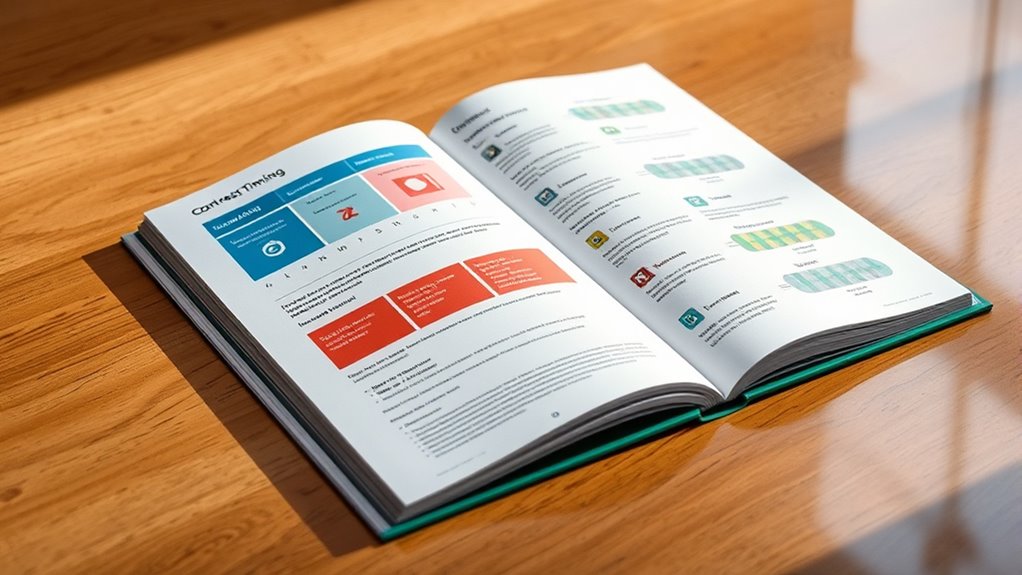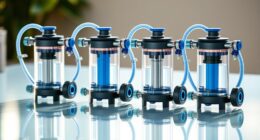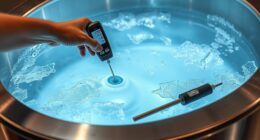To maximize contrast therapy, follow proper timing for each phase: spend 15-20 minutes on heat, then wait 1-3 minutes before switching to cold for 10-20 minutes, cycling 4-6 times based on your response. Always listen to your body—stop if discomfort worsens—and facilitate smooth transitions to prevent injury. Precision timing boosts recovery, blood flow, and healing effects. Keep exploring to learn more about customizing your perfect contrast routine.
Key Takeaways
- Wait 1-3 minutes after hot therapy before applying cold to allow body stabilization.
- Limit cold sessions to 10-20 minutes and ensure at least 1 hour before reapplication.
- Apply heat for 15-20 minutes to maximize muscle relaxation without causing burns.
- Use 1-3 minute cycles for cold and heat, typically completing 4-6 cycles per session.
- Monitor body signals and adjust timing to prevent overexposure and ensure safe, effective contrast therapy.
Understanding Contrast Therapy: The Basics
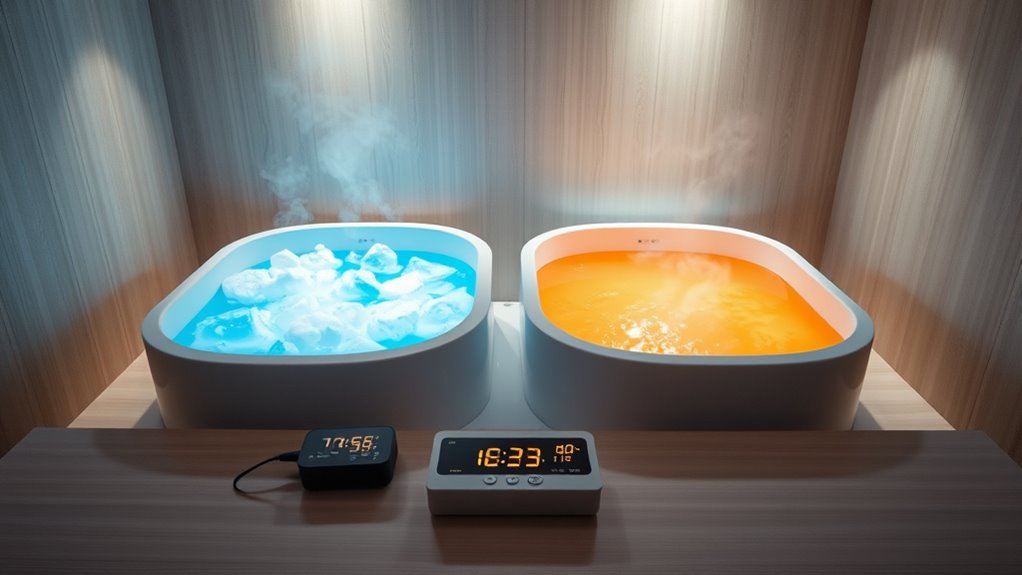
Contrast therapy involves alternating between hot and cold treatments to promote recovery and reduce pain. This method helps relax muscles, easing tension and preventing stiffness. When you switch between heat and cold, the hot application increases blood flow, which facilitates muscle relaxation and delivers nutrients for healing. Cold therapy, on the other hand, reduces inflammation and numbs pain, providing immediate relief. Together, these contrasting temperatures work synergistically to accelerate recovery, minimize soreness, and improve mobility. You might feel a soothing warmth followed by an invigorating cold, which stimulates circulation and eases discomfort. Understanding the temperature contrast and how it influences circulation can help you harness contrast therapy more effectively to target pain and support your body’s natural healing processes.
Why Timing Matters in Contrast Therapy
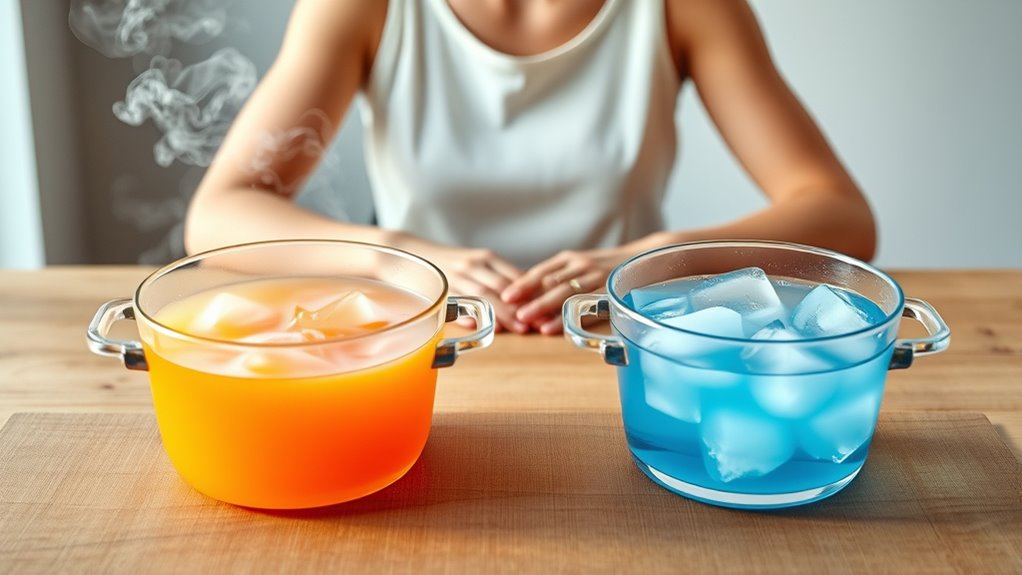
Timing is essential in contrast therapy because it helps you recover more efficiently and avoid overstressing your tissues. When you manage the intervals correctly, you enhance the overall benefits and prevent overload. Proper timing guarantees you get the most out of each session without risking setbacks. Incorporating energy balance into your timing strategy can further optimize the healing process and support your spiritual well-being.
Enhances Recovery Efficiency
When you apply contrast therapy at ideal times, it considerably boosts your recovery efficiency. Proper timing promotes muscle relaxation, helping your muscles loosen and recover faster. Alternating between hot and cold stimulates blood flow, which accelerates the removal of metabolic waste and delivers nutrients to damaged tissues. This process enhances pain relief by reducing inflammation and soothing soreness. When you time your sessions correctly, you maximize these benefits and shorten your recovery period. Well-timed contrast therapy guarantees your tissues respond at their best, preventing stagnation and promoting faster healing. Additionally, understanding the contrast ratio of your projector can help optimize your viewing environment for a more immersive experience. By syncing your therapy with your body’s needs, you not only ease discomfort but also set the stage for quicker, more effective recovery. Ultimately, timing is the key to opening the full potential of contrast therapy.
Prevents Tissue Overload
Applying contrast therapy at the wrong times can lead to tissue overload, which hampers recovery rather than helps it. Overdoing cold exposure or switching too quickly between hot and cold can strain your tissues instead of aiding them. To prevent this:
- Limit cold exposure sessions to avoid excessive stress on tissues, giving your body time to recover.
- Use proper timing between hot and cold cycles to prevent shock and overload, allowing tissues to adapt gradually.
- Pay attention to your body’s signals—if you feel pain or discomfort, pause to avoid tissue damage.
- Incorporate vetted portable cooling and heating options to ensure safe and effective temperature management during therapy.
Timing is essential to ensure your tissues recover effectively without overload. Properly scheduled contrast therapy supports tissue recovery by balancing cold exposure and heat, preventing setbacks in your healing process.
Maximizes Therapeutic Benefits
Properly timed contrast therapy enhances its therapeutic benefits by ensuring your tissues respond ideally to temperature changes. When you alternate hot and cold, you promote effective temperature regulation, which boosts blood flow to targeted areas. This increased circulation helps deliver oxygen and nutrients while removing waste products, accelerating recovery and reducing pain. Timing is essential—if you switch too quickly, your tissues may not respond fully, diminishing benefits. Conversely, too long a duration can cause overstimulation or tissue overload. By following precise timing, you optimize the natural responses of vasodilation and vasoconstriction, maximizing healing. Incorporating sound design techniques such as audio cues can also help guide the timing of treatment sessions for enhanced effectiveness. Consistent, well-timed contrast sessions ensure you get the most from each treatment, making your therapy more effective and your recovery faster.
Recommended Duration for Cold Applications
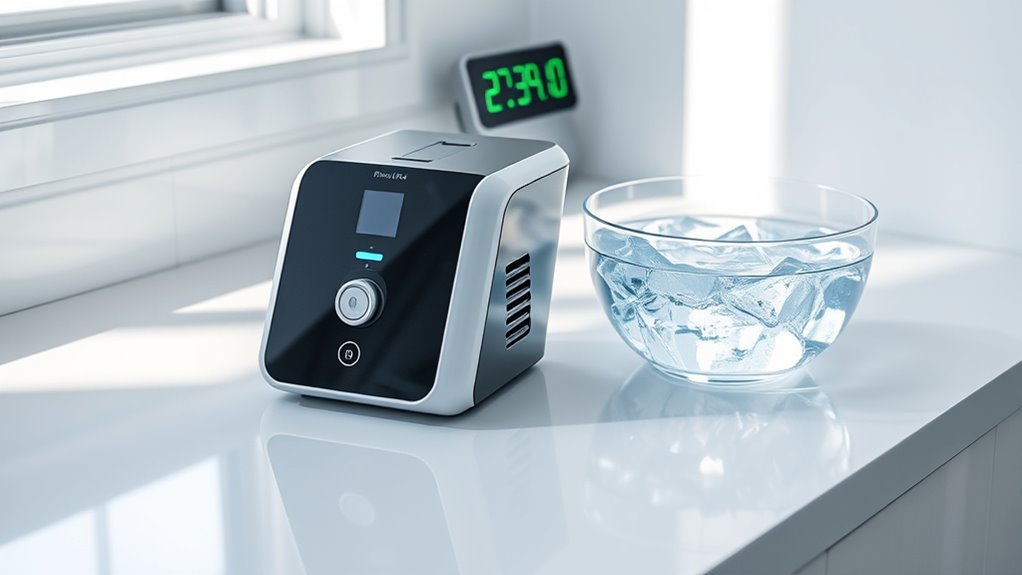
When using cold applications, it’s important to stick to the recommended duration to avoid skin damage or frostbite. The ideal time can vary depending on the injury type and location, so adjusting accordingly is key. Overusing cold therapy can lead to safety concerns, so always follow guidelines to prevent risks. Additionally, understanding personal finance management can help individuals budget for healthcare needs related to injuries.
Optimal Cold Duration
What is the ideal length for cold therapy to maximize benefits without risking tissue damage? Generally, keeping ice duration between 10 to 20 minutes is effective. Exceeding this can lead to tissue damage or frostbite, so timing is essential. To optimize your cold application, consider these tips:
- Limit ice duration to 10-20 minutes for safety.
- Allow at least 1-hour intervals before reapplying to prevent overcooling.
- Coordinate with heat timing—wait at least 30 minutes after cold therapy before applying heat to avoid counteracting effects.
- Always verify proper regulation and safety guidelines to prevent adverse effects.
Injury Type Considerations
Different injury types require tailored cold therapy durations to optimize healing and prevent further damage. For a muscle strain, applying cold for 15 to 20 minutes every hour during the first 48 hours helps reduce inflammation and numb pain without causing tissue damage. If you’ve sustained a joint sprain, shorter sessions of 10 to 15 minutes may be more effective, especially if swelling is significant. Overexposing the area to cold can hinder recovery, so pay attention to your body’s response. For both muscle strains and joint sprains, avoid prolonged cold application beyond recommended times to prevent frostbite or tissue damage. Adjust the duration based on severity, but always prioritize safe, controlled cold therapy to support proper healing. Monitoring for symptoms of breast cancer is also important for overall health awareness, even when managing injuries.
Safety and Overuse Risks
While cold therapy can effectively reduce pain and inflammation, overusing it can pose significant safety risks. To manage these risks, you should follow proper safety precautions and limit cold applications. Here are key points for safe practice:
- Avoid applying cold for more than 15-20 minutes at a time to prevent tissue damage.
- Always use a barrier, like a towel, between the cold source and your skin to prevent frostbite.
- Monitor your skin for signs of excessive cold, such as numbness or discoloration, and remove the application immediately if these occur.
- Incorporating exfoliation techniques such as glycolic acid may help in preparing the skin to better tolerate cold therapy, reducing the risk of adverse reactions.
Proper risk management involves respecting these limits and listening to your body. This approach helps prevent adverse effects while maximizing the benefits of cold therapy.
Recommended Duration for Heat Applications
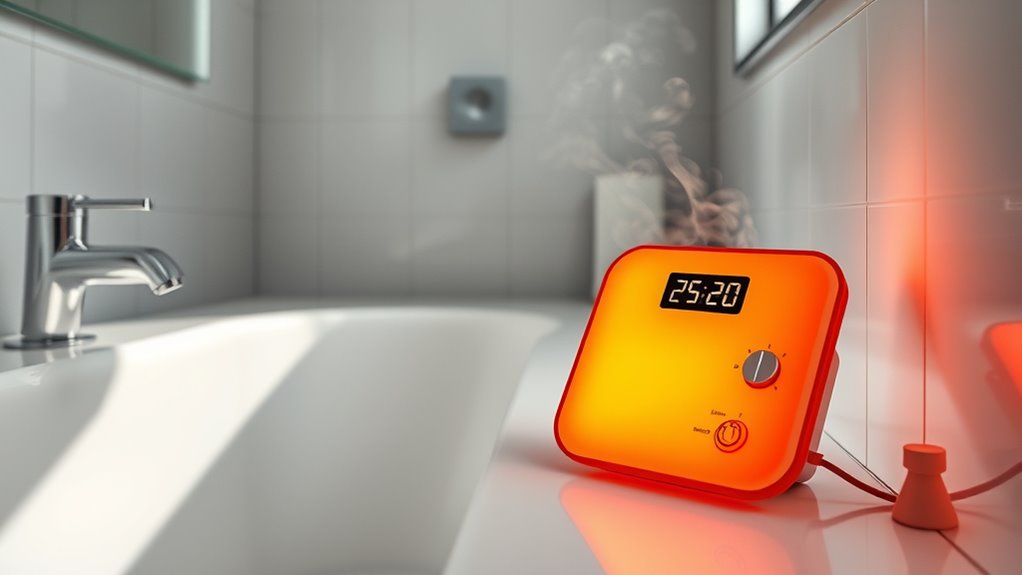
To maximize the benefits of heat therapy and avoid potential skin damage, it’s important to stick to recommended durations. Generally, applying heat for 15 to 20 minutes is effective for muscle relaxation and improving joint flexibility. Shorter sessions may not provide enough warmth to loosen tight muscles or increase blood flow, while longer ones can risk skin irritation or burns. Make certain the heat source is comfortable and not too hot, and always listen to your body’s signals. If you feel any discomfort or excessive redness, remove the heat immediately. Using consistent timing helps your body adapt and gains from heat therapy become more effective. Proper projector bulb maintenance, such as regular cleaning and timely replacement, can also ensure optimal heat output and safety during heat applications. Stick to these guidelines to safely enhance your recovery and comfort.
Optimal Transition Times Between Heat and Cold
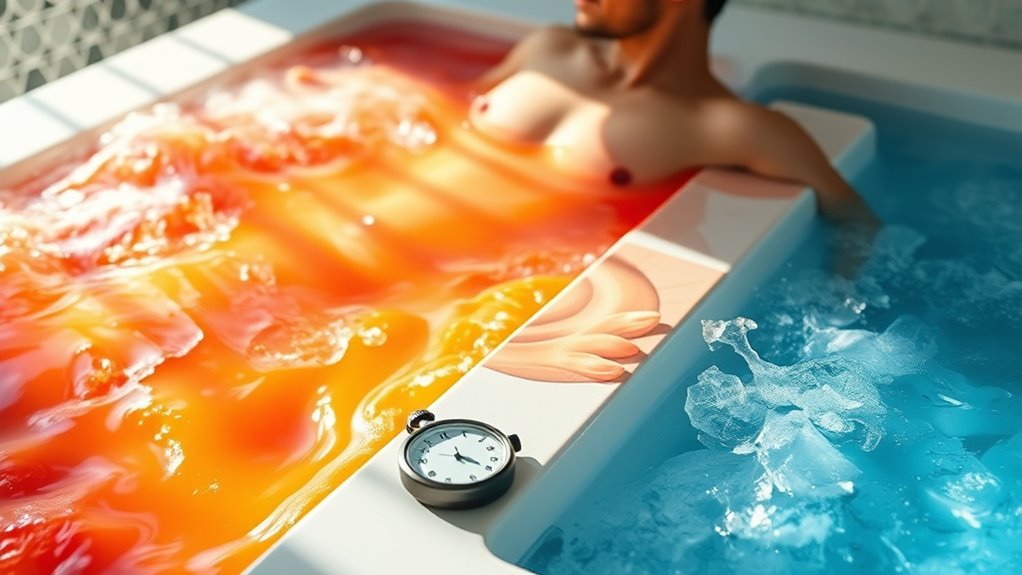
After completing a heat application, giving your body a brief pause before switching to cold therapy can enhance recovery benefits. This changeover period helps manage temperature gradients, reducing shock and optimizing circulation. To do this effectively:
- Wait 1-3 minutes to allow your body temperature to stabilize, preventing rapid shifts.
- Ensure your equipment is properly calibrated, maintaining consistent temperatures for safe transitions.
- Observe your body’s response before moving to cold therapy, adjusting timing if needed based on comfort or sensation.
Proper timing minimizes abrupt changes in temperature gradients, which can cause discomfort or adverse effects. Calibration ensures your devices deliver accurate heat and cold levels, making your contrast therapy safer and more effective. Taking these steps helps maximize recovery while keeping your experience safe and comfortable.
How Many Cycles Should You Perform?
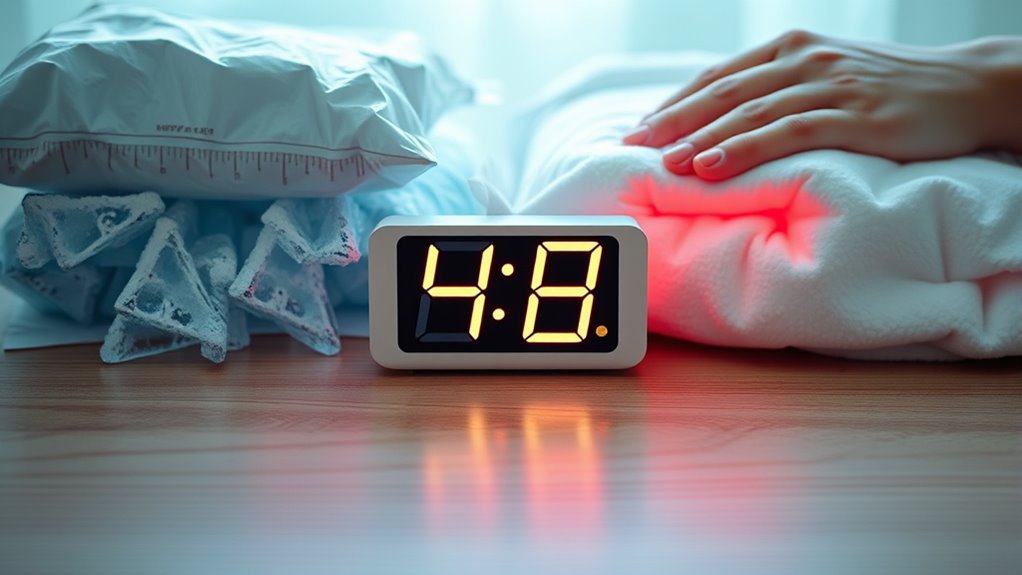
Determining the right number of contrast therapy cycles depends on your individual goals and how your body responds. If you’re focusing on muscle recovery, start with 3 to 4 cycles, each lasting 1 to 3 minutes of cold followed by heat. For pain relief, you might perform more cycles, but keep each session within a safe range to avoid overtaxing your body. Pay attention to how your muscles feel after each cycle—if you notice increased soreness or discomfort, adjust accordingly. Typically, 4 to 6 cycles are effective for most people, but your specific needs may vary. Remember, consistency is key, and listening to your body’s signals will help you optimize benefits while avoiding overstimulation.
Listening to Your Body: Signs You Need a Break
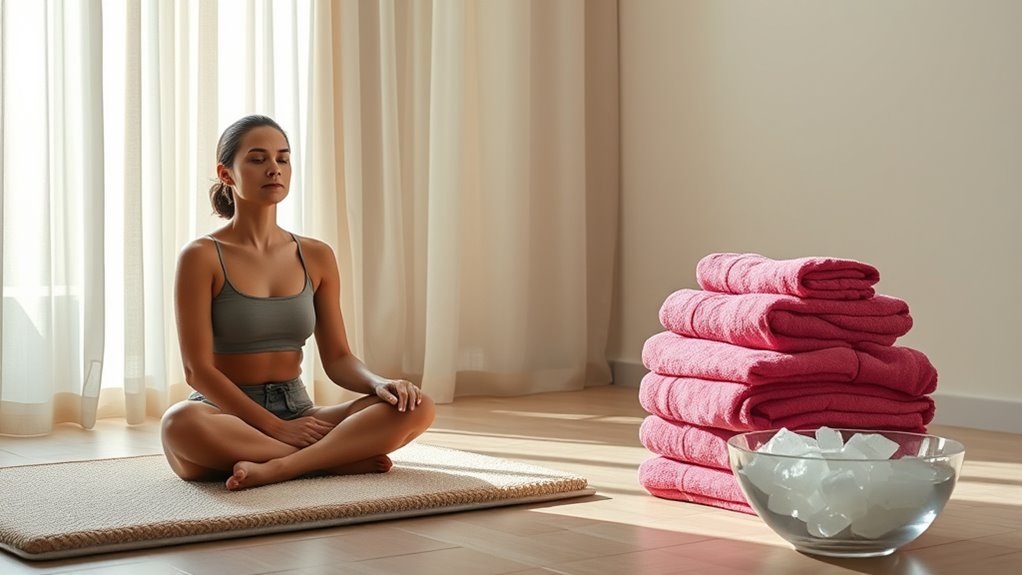
Listening to your body is essential during contrast therapy sessions because your muscles and mind will signal when they need a break. Pay attention to signs like increasing muscle tension or discomfort, which indicate it’s time to pause. If you experience persistent pain relief issues or feel overwhelmed, these are clear cues to step back. To stay in tune, watch for these signals:
- Heightened muscle tension or stiffness
- Numbness or tingling sensations
- Unusual discomfort or pain that worsens
Recognizing these signs helps prevent overexertion and ensures safe, effective therapy. Taking breaks when needed allows your body to recover and maximizes the benefits of contrast therapy without risking injury or diminishing pain relief. Trust your instincts and listen closely to what your body tells you.
Common Mistakes to Avoid in Timing

One common mistake in contrast therapy timing is starting or ending sessions too abruptly, which can reduce the therapy’s effectiveness. Sudden temperature fluctuation can shock your body, making it harder to achieve the desired benefits. Maintaining timing consistency is vital; inconsistent intervals can diminish the therapy’s positive effects and hinder your progress. Rushing through the hot and cold cycles or not allowing enough time for your body to adapt can lead to less effective results. To avoid this, stick to a steady rhythm and give your body time to respond gradually. Proper timing ensures your body benefits fully from temperature changes without unnecessary stress or discomfort. Being mindful of these mistakes helps maximize the healing and recovery benefits of contrast therapy.
Creating Your Personalized Contrast Therapy Schedule
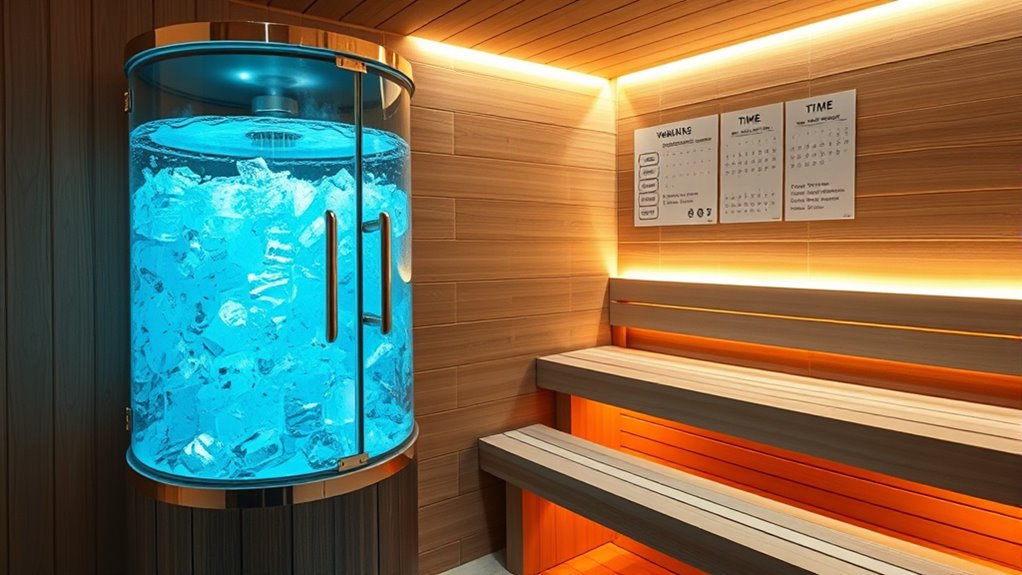
Creating your personalized contrast therapy schedule involves tailoring the timing and sequence of hot and cold sessions to suit your specific needs and goals. To effectively apply heat and cold contrast, consider these key steps:
Design your contrast therapy schedule by customizing timing and sequence to meet your unique needs and goals.
- Determine your primary goal—whether reducing soreness or boosting circulation—and set session durations accordingly.
- Schedule alternating hot and cold treatments, starting with applying heat to relax muscles, then switching to cold to reduce inflammation.
- Adjust the cycle length based on your response; typical sessions involve 1-3 minutes of applying heat followed by 30 seconds to 1 minute of cold contrast.
Frequently Asked Questions
Can Contrast Therapy Help With Specific Medical Conditions?
Contrast therapy, involving cold immersion and heat application, can help manage certain medical conditions like muscle soreness, inflammation, and joint pain. You might find relief by alternating between cold and heat, which reduces swelling and improves circulation. However, it’s crucial to consult your healthcare provider before using contrast therapy for specific conditions, especially if you have cardiovascular issues or nerve problems, to ensure it’s safe and effective for your needs.
How Does Contrast Therapy Affect Muscle Recovery?
You might think contrast therapy’s just about soothing muscle soreness, but it actually accelerates recovery by boosting blood flow and reducing inflammation. Ironically, the cold helps reduce inflammation, while the heat promotes healing—working together to ease soreness faster. You’ll notice less muscle soreness and quicker recovery times, making contrast therapy a smart choice for anyone wanting to bounce back quickly and feel better sooner.
Are There Age Restrictions for Contrast Therapy?
There are generally no strict age limitations for contrast therapy, but safety considerations are essential. If you’re older or have health issues, consult your healthcare provider first. This guarantees the therapy’s safe for your specific condition. Younger individuals usually tolerate it well, but always listen to your body. Adjust temperature and duration accordingly, and avoid contrast therapy if you have skin sensitivities or circulatory problems.
Can Contrast Therapy Be Combined With Other Treatments?
Imagine your body as a symphony, each treatment a vital note. Yes, you can combine contrast therapy with other treatments—like hydrotherapy benefits amplify with temperature cycling, creating harmonious healing. Mixing therapies can enhance circulation, reduce inflammation, and accelerate recovery. Just guarantee you consult a professional to tailor the blend to your needs, so each note resonates perfectly, revealing deeper healing and restoring your body’s natural rhythm.
How Do Environmental Factors Influence Contrast Therapy Effectiveness?
Environmental factors like temperature regulation and ambient humidity critically influence contrast therapy’s effectiveness. If the environment is too humid or temperature-controlled improperly, your body struggles to switch between hot and cold, reducing benefits. Make sure the room is well-ventilated, with consistent ambient temperature and low humidity. This helps your body respond better to temperature changes, maximizing circulation, pain relief, and recovery during contrast therapy sessions.
Conclusion
Now that you know the ins and outs of contrast therapy timing, picture yourself seamlessly moving between soothing heat and invigorating cold, like gentle waves crashing on a shoreline. Trust your body’s signals and craft a routine that feels just right, like a well-tuned symphony. With mindful timing, you’ll discover the full healing potential of contrast therapy, transforming sessions into a calming, revitalizing journey you’ll want to revisit again and again.
